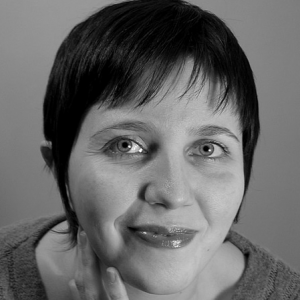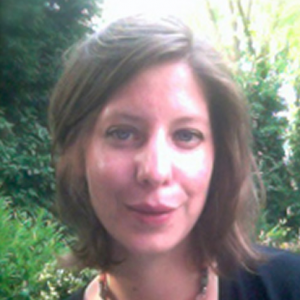For the Love of Yeast
A little cell at the cutting edge of big science
— for Maria ‘Mara’ Nardelli —
Chapter 1
Manchester, the post-industrial heart and hub of north England, is known for football fanaticism, the pop gloom and swoon of The Smiths, a constant drizzle of dreary weather, and—to a select few—the collaborative work churning in an off-white university building in the city’s center. Given the town’s love of the pub, perhaps it’s a kind of karma that the Manchester Centre for Integrative Systems Biology (MCISB) has set up shop here: its researchers are devoted to yeast.
Wayne Aubrey, a postdoc in his early thirties, with a windswept foppish bob and round, kind brown eyes, is one of those special researchers. Early on a spring morning in 2012, Wayne moved swiftly from his bike to a small glass security gate outside the Centre. Outdoorsy and originally from Wales, he’d just returned from a snowboarding trip, trading in the deep white of powder-fresh mountains for the new, off-white five-story university outpost looming in front of him.
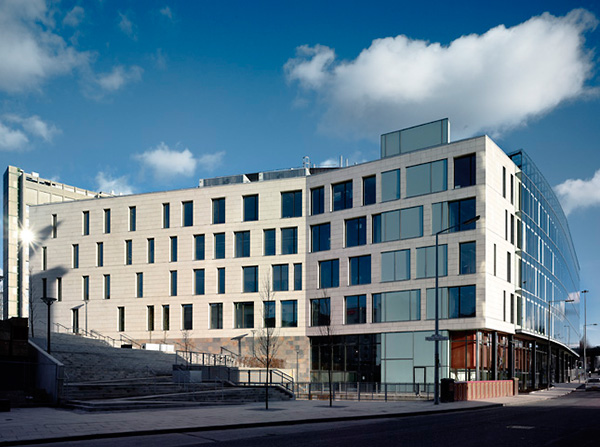
Manchester Interdisciplinary Biocentre by Wikipedia Commons member Mjsslb
The building, called the Manchester Interdisciplinary Biocentre (MIB), features an open-plan design, intended to foster collaboration among biochemists, computer scientists, engineers, mathematicians, and physicists. The building also hosts the Manchester Centre—the MCISB—where Wayne and his colleagues work. Established in 2006 and funded by a competitive grant, the MCISB was intended to run for at least ten years, studying life by creating computer models that represent living organisms, such as yeast. At its height in 2008, the multidisciplinary Centre housed about twelve full-time postdocs from a wide array of scientific fields, all working together—an unusual, innovative approach to science. But in the age of budget cuts and changing priorities, the funding was already running out after only six years, leaving the Centre’s work on yeast, the jobs of Wayne’s colleagues, and Wayne’s own career path hanging in the balance.
Nevertheless, for the moment at least, there was work to be done. Wayne climbed three flights of stairs and grabbed his lab coat. Wayne’s background, like that of most of his colleagues at the Centre, is multidisciplinary: before coming to Manchester, he was involved in building “Adam,” a robot scientist that automates some experiments so human scientists don’t have to conduct and run each one. This special background in both biology and computer science landed Wayne the job in the Manchester Centre.
But on this day, his lab work was that of a classic “wet biologist.”
As he unstacked a pile of petri dishes into a neat line, Wayne reported with a quick smile, “We grow a lot of happy cells.” The lab is like a sterile outgrowth of or inspiration for The Container Store: glass and plastic jars, dishes, bottles, tubes, and flasks, all with properly sized red and blue sidekick lids, live on shelves above rows of lab counters. Tape and labeling stickers protrude somewhat clumsily from various drawers and boxes; they get a lot of use. Small plastic bins, like fish tackle boxes with near translucent tops, sit at every angle along the counters. Almost as a necessary afterthought, even in this multidisciplinary center, computer monitors are pushed in alongside of it all, cables endlessly festooned between shelves and tables.
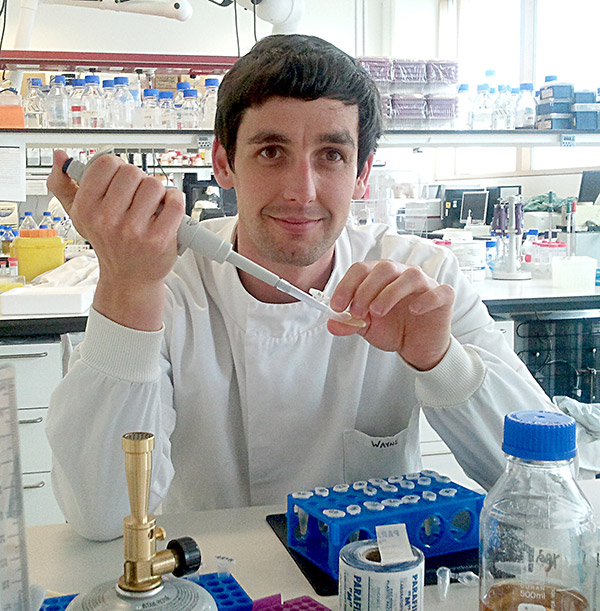
Wayne in the Lab
Wayne picked up a flask of solution, beginning the routine of pouring measured amounts into the dishes’ flat disks. “The trick,” he noted, “is to prevent bubbles, so that the only thing visible in the dishes later is yeast.”
Every lab has its own romances and rhythms, its own ideals and intrigues—and its own ritualistic routines of daily prep.
As one of the organisms often used for biology, yeast has been at the lab bench for centuries. You could say it’s the little black dress of biology labs. Biologists keep it handy because, as a simple, single-cell organism, yeast has proven very functional, versatile, and useful for all sorts of parties—if, that is, by “parties,” you mean methodical and meticulous experiments, each an elaborate community effort.
How yeast became the microbiologist’s best friend has everything to do with another party favorite (and big business): alcohol. Industrialists and governments alike paid early biologists and chemists to tinker with the fermentation process to figure out why beer and wine spoiled so easily. The resulting research tells an important story, not only about the development of modern biology, but about the process of scientific advance itself.
In modern labs, yeast is most often put to work for the secrets it can unlock regarding human health. Through new experiments and computer models, systems biologists are mapping how one cell of yeast functions as a living system. Though we know a lot about the different components that make up a yeast cell—genes, proteins, enzymes, etc.—we do not yet know how these different components interact together to comprise living yeast. The researchers working at the Manchester Centre are studying this living system, trying to understand these interactions and make them visible. Their ultimate goal: to create a computer model of yeast that can show how the different elements interact. Their hope is that this model of yeast will shed light on how more complex systems—a heart, say, or a liver, or even a whole human being—function, fail, survive, and thrive.
But a model of yeast would demand and have to make sense of enormous quantities of data. Next to the petri dishes, Wayne set up pipettes, flasks, and a plastic tray, his behavior easy and measured. But this experiment, complicated and time-sensitive, couldn’t be performed solo. Wayne was waiting for Mara Nardelli, his lab partner and fellow yeast researcher. When she arrived, they would begin a quick-paced dance from dish to dish, loading each with sugar to see exactly how quickly yeast eats it. They hoped the experiment would give them clear numerical data about the rate of yeast’s absorption of sugar. If it were to match other findings, then perhaps it might be useful to Wayne and Mara’s other lab mates—fellow systems biologists who were attempting to formulate yeast and its inner workings into mathematical terms and then translate those terms into visual models.
Devising a computerized model of yeast has been the main goal of the Manchester Centre—but after six years, it seems it’s still a ways off. Farther off, to be honest, than anyone had really expected. Yeast seemed fairly straightforward: it is a small, simple organism contained completely in one cell. And yet, it has proved surprisingly difficult to model. Turns out, life—even for as “simple” an organism as yeast—is very complex.
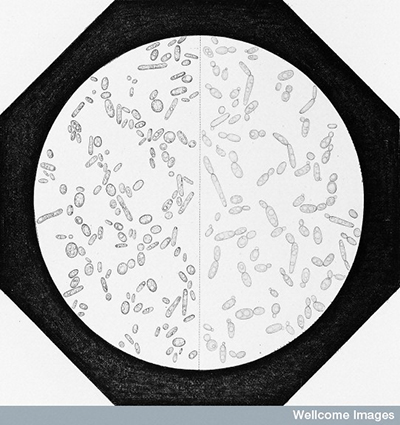
Yeast cells in a sugar broth, disjoint (left) and (right). Image Courtesy of Wellcome Trust Image Library
It seems odd, Wayne conceded, that after hundreds of years of research, we still don’t know how yeast works. “But,” he countered, “yeast remains the most well understood cell in the world. I know more about yeast than about anything else, and there are probably as many yeast biologists in the world as there are genes in yeast—which is six thousand.” The sheer number of genes helped Wayne underscore yeast’s complexity: “To fully map the interactions, you have to look at the ways in which these 6,000 genes interact, so that means (6000×5999)/2, which is nearly 18 million potential interactions. You cannot imagine!” And the complexity doesn’t stop there, Wayne continued: “Now you have the interactions between the genes, but you would still need to add the interactions of all the other components of the yeast cell in order to create a full model.” That is, you’d have to take into account the various metabolites and other elements that make up a yeast cell.
Despite the travails of the yeast modelers, the field of systems biology still hopes to model even more complex forms of life to revolutionize medicine: British scientist and systems biology visionary Denis Noble has had a team working on a virtual model of the heart for more than twenty years, while a large national team of German researchers, funded by the German Federal Ministry, is developing a virtual liver model. Yet, if we cannot even understand how a single-cell organism functions as a living system, one might reasonably ask whether we can safely scale up to bigger, more complex organisms. Could we really—as some scientists hope—eventually model a complete human being?
Moreover, will we be able to use these models to improve human health and care? Will systems biology bring us systems medicine? The American systems biologist Leroy Hood, who was recently awarded the prestigious National Medal of Science by President Obama, has called this idea “P4 medicine”—the p’s standing for Predictive, Preventive, Personalized, and Participatory. He imagines that heart and liver models could be “personalized,” meaning that everybody would have his or her own model, based on individual genetic and other biological information. Just as you can now order your own genetic profile (for a price), you would be able to have a model of yourself, which doctors could use to diagnose—or even “predict”—your medical problems. Based on the model, “preventive” measures could also be taken. And it’s not only medical professionals who could help to cure and prevent disease, but the patient, too, could “participate” in this process.
For instance, in the case of heart diseases, a model could more clearly show existing problems or future risks. This could help doctors run specific tests, perform surgery, or prescribe medicine; and patients themselves could also use special electronic devices or mobile phone apps to measure cholesterol, monitor their heartbeat, and adjust eating patterns and physical activity in order to reduce risks. Or a patient could use a model of his or her liver—the organ that digests drugs—to determine what drugs are most effective, what sort of dose to take, and at what time of the day. Healthcare would increasingly become more individually tailored and precise, and people could, in effect, become their own technology-assisted doctors, managing their own health, and living longer, healthier lives because of it.
It sounds pretty amazing—and if the systems biologists are right about our ability to build complex models, it could be a reality someday. But are they right, or are they overly optimistic? Researchers’ experience with yeast suggests that a personalized model of your liver on ten years of antidepressants and another of your heart recovering from invasive valve repair could be further off than we’d like. They might even be impossible.
It was turning out to be hard enough to model the simple single-cell organism of yeast. But doing so might be the crucial first step, and the yeast researchers at the Centre weren’t ready to give up yet. Far from it. As Wayne finished setting up the last of the petri dishes, Mara walked in. Golden-skinned, good-natured, and outgoing, she was the social center of the MCISB. For a moment, she and Wayne sat at the lab bench, reviewing the preparations for the day’s experiment in a sort of conversational checklist.
Then Mara stood, tucking away her thick Italian curls and looking over the neatly arranged high-tech Tupperware party. She sighed and turned back to Wayne. “Ready?”
Chapter 2
People had been using yeast—spooning off its loamy, foamy scum from one bread bowl or wine vat and inserting it in another—for thousands of years before they understood what this seething substance was or what, exactly, it was doing. Hieroglyphs from ancient Egypt already suggested yeast as an essential sidekick for the baker and brewer, but they didn’t delineate its magic—that people had identified and isolated yeast to make bread rise and grape juice spirited was magic enough. As the great anatomist and evolutionary theory advocate Thomas Henry Huxley declared in an 1871 lecture, “It is highly creditable to the ingenuity of our ancestors that the peculiar property of fermented liquids, in virtue of which they ‘make glad the heart of man,’ seems to have been known in the remotest periods of which we have any record.”
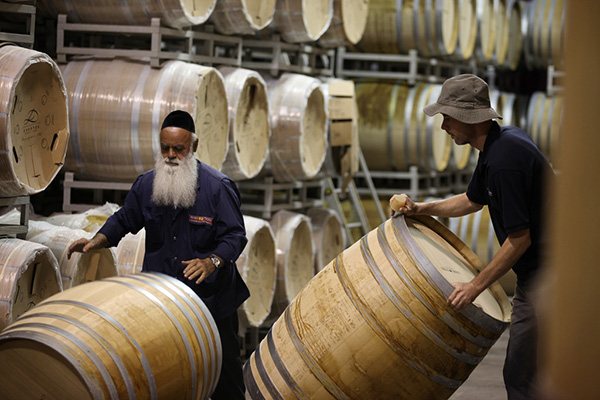
Wine barrels. Image Courtesy of StateofIsrael via Flickr.
All the different linguistic iterations of yeast—gäscht, gischt, gest, gist, yst, barm, beorm, bären, hefe—refer to the same descriptive action and event: to raise, to rise, to bear up with, as Huxley put it, “‘yeasty’ waves and ‘gusty’ breezes.” This predictable, if chaotic and muddy, pulpy process—fermentation—was also known to purify the original grain down to its liquid essence—its “spirit”—which, as Huxley described it, “possesses a very wonderful influence on the nervous system; so that in small doses it exhilarates, while in larger it stupefies.”
Though beer and wine were staples of everyday living for thousands and thousands of years, wine- and beer-making were tough trades—precisely because what the gift of yeast was, exactly, was not clear. Until about 150 years ago, mass spoilage of both commercial and homemade alcoholic consumables was incredibly common. Imagine your livelihood or daily gratification dependent on your own handcrafted concoctions. Now, imagine stumbling down to your cellar on a damp night to fetch a nip or a barrel for yourself, your neighbors, or the local tavern. Instead you’re assaulted by a putrid smell wafting from half of your wooden drums. You ladle into one of your casks and discover an intensely sour or sulfurous brew. In the meantime, some drink has sloshed onto your floor, and the broth’s so rancid, it’s slick with its own nasty turn. What caused this quick slippage into spoilage? This question enticed many an early scientist to the lab bench—in part because funding was at the ready.
In a 2003 article on yeast research in the journal Microbiology, James A. Barnett explains that because fermentation was so important to daily life and whole economies, scientific investigations of yeast began in the seventeenth century and were formalized in the eighteenth century, by chemists—not “natural historians” (as early biologists were called)—who were originally interested in the fermentation process as a series of chemical reactions.
In late eighteenth-century Florence, Giovanni Valentino Fabbroni was part of the first wave of yeast research. Fabbroni—a true Renaissance man who dabbled in politics and electro-chemistry, wrote tomes on farming practices, and helped Italy adapt the metric system—determined that in order for fermentation to begin, yeast must be present. But he also concluded his work by doing something remarkable: Fabbroni categorized yeast as a “vegeto-animal”—something akin to a living organism—responsible for the fermentation process.
Two years later, in 1789 and in France, Antoine Lavoisier focused on fermentation in winemaking, again regarding it as a chemical process. As Barnett explains, “he seem[ed] to be the first person to describe a chemical reaction by means of an equation, writing ‘grape must = carbonic acid + alcohol.’” Lavoisier, who was born into the aristocracy, became a lawyer while pursuing everything from botany to meteorology on the side. At twenty-six, he was elected to the Academy of Sciences, bought part of a law firm specializing in tax collection for the state, and, while working on his own theory of combustion, eventually came to be considered France’s “father of modern chemistry.” The French government, then the world’s top supplier of wine (today, it ranks second, after Italy), needed Lavoisier’s discoveries—and badly, too: France had to stem the literal and figurative spoiling of its top-grossing industry. But as the revolution took hold, Lavoisier’s fame and wealth implicated him as a soldier of the regime. Arrested for his role as a tax collector, Lavoisier was tried and convicted as a traitor and decapitated in 1794. The Italian mathematician and astronomer Joseph-Louis Lagrange publicly mourned: “It took them only an instant to cut off his head, and one hundred years might not suffice to reproduce its like.”
Indeed, Lagrange was onto something: the new government’s leaders were very quickly in want of scientific help for the wine and spirits industries. In 1803, the Institut de France offered up a medal of pure gold for any scientist who could specify the key agent in the fermenting process. Another thirty years passed before the scientific community had much of a clue—and its discovery tore the community apart.
By the 1830s, with the help of new microscope magnification, Friedrich Kützing and Theodor Schwann, both Germans, and Charles Cagniard-Latour, a Frenchman, independently concluded that yeast was responsible for fermenting grains. And much more than that: these yeasts, the scientists nervously hemmed, um, they seemed to be alive.
Cagniard-Latour focused on the shapes of both beer and wine yeasts, describing their cellular bulbous contours as less like chemical substances and more resembling organisms in the vegetable kingdom. Schwann pushed the categorization even further: upon persistent and continued microscopic investigations, he declared that yeast looks like, acts like, and clearly is a member of the fungi family—“without doubt a plant.” He also argued that a yeast’s cell was essentially its body—meaning that each yeast cell was a complete organism, somewhat independent of the other yeast organisms. Kützing, a pharmacist’s assistant with limited formal training, published extensive illustrations of yeast and speculated that different types of yeast fermented differently; his speculation was confirmed three decades later. From their individual lab perches, each of the three scientists concluded the same thing: yeast is not only alive, but it also eats the sugars of grains or grapes, and this digestion, which creates acid and alcohol in the process, is, in effect, fermentation.
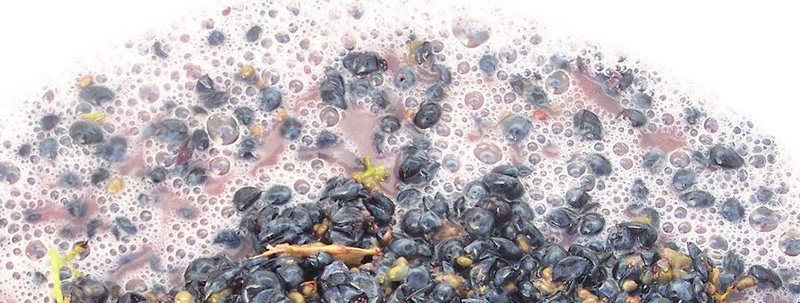
Fermenting Wine Grapes
This abrupt reframing of fermentation as a feat of biology caused a stir. Some chemist giants in the field, like Justus von Liebig, found it flat out ridiculous. A preeminent chemistry teacher and theorist, von Liebig proclaimed that if yeast was alive, the growth and integrity of all science was at grave risk: “When we examine strictly the arguments by which this vitalist theory of fermentation is supported and defended, we feel ourselves carried back to the infancy of science.” Von Liebig went so far as to co-publish anonymously (with another famous and similarly offended chemist, Friedrich Wöhler) a satirical journal paper in which yeasts were depicted as little animals feasting on sugar and pissing and shitting carbonic acid and alcohol.
Though he himself did little experimental research on yeast and fermentation, von Liebig insisted that the yeasts were just the result of a chemical process. Chemical reactions could perhaps produce yeast, he allowed, but the yeasts themselves could never be alive, nor active, nor the agents of change.
Von Liebig stuck to this story even after Louis Pasteur, another famous chemist, took up yeast study and eventually became the world’s first famous microbiologist because of it.
These long-term investigations into and disciplinary disputes about the nature of yeast reordered the scientific landscape: the borders between chemistry and biology shifted, giving way to a new field: microbiology—the study of the smallest forms of life.
Chapter 3
Back in modern Manchester, Mara and Wayne danced a familiar dance. Behind the lab bench, their arms swirled in clocklike precision as they fed the yeast cells a sugar solution in patterned and punctuated time frames, and then quickly pipetted the yeast into small conical PCR tubes.
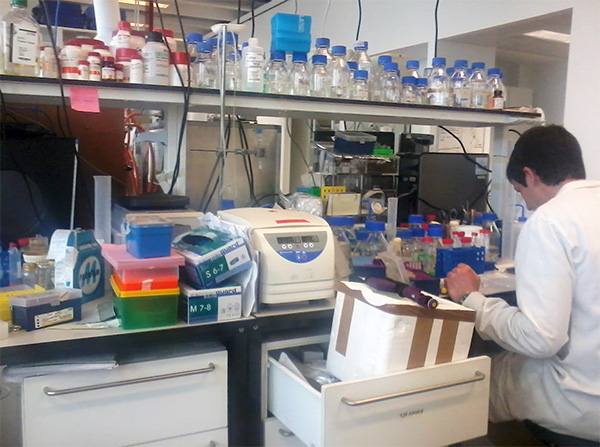
Lab at Manchester Interdisciplinary Biocentre.
Soon, Mara held a blue plastic tray of upside-down conical tubes, which she slowly guided into the analysis machine sitting on top of the lab counter. The machine looked like the part of a desktop computer that houses the motherboard, the processor, the hard drive, its fan, and all sorts of drives and ports. It’s the width of at least two of these bulky and boxy system units, and half of it is sheen with tinted windows. Thick cables and a hose streamed from its backside like tentacles.
Biologists have a favorite joke about yeast: like men, it’s only interested in two things—sex and sugar. Wayne explained, “This is because yeast has one membrane protein, or cell surface receptor, that binds sugar and one that binds the pheromone of the other mating type.” Sugar uptake is what Mara and Wayne have been investigating: the big machine scans, measures, and analyzes how and how quickly the yeast has its way with sugar. Results appear on the front screen, translating the experiment’s results into numerical data and graphs. The results for each set of tubes are cast into a graph, showing the pattern of the yeast cells’ sugar uptake over time. Usually, the graphs show the same types of patterns—lines slowly going up or down—with little variance from graph to graph. If great discrepancies in the patterns emerge, then the scientists usually know something went wrong in the experiment. Mara and Wayne and the Centre’s “dry biologists” (those who build mathematical models of yeast with computers) hoped that understanding how yeast regulates its sugar uptake would help them better understand how the cells grow. Yeast cells grow quickly and can be seen as a proxy for human cell generation because processes in both cells are similar. So much about yeast, Wayne explained, is directly applicable to human cells. If we know more about how yeast cells work, we’ll have a better sense of how human cells function or malfunction. Understanding the development and growth of yeast cells can be translated to growth in healthy human cells, as well as in unhealthy human cells—like malignant cancer cells.
Mara has been at the lab working with yeast for a long time. In many ways, Mara has been with the Centre before it even became the Centre. Fourteen years ago, in 1998, Mara was wooed away from her beloved Italy for a postdoc in Manchester. Even though she moved here reluctantly from Puglia, a particularly sweet spot on the heel of Italy’s boot, she became a Mancunian—an inhabitant of Manchester. Her childhood sweetheart followed her to Manchester, and together they had a son, who himself wound up at the University of Manchester. Mara even wrote a blog about Manchester living for fellow Britain-bound Italians.
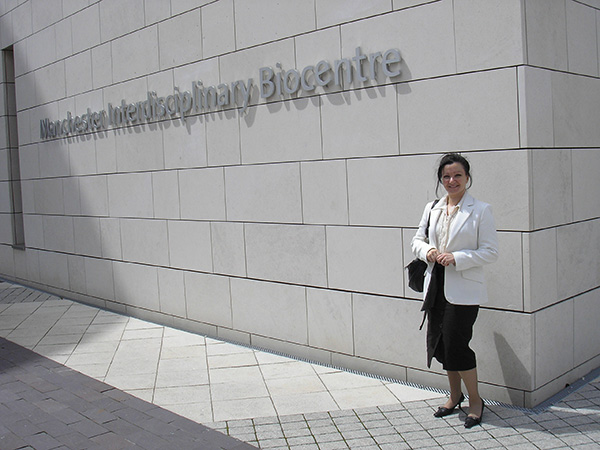
Mara at the Manchester Interdisciplinary Biocentre.
Mara’s research background was in biochemistry. She obtained her PhD from the University of Naples Federico II and University of Bari, and then continued in Bari as a Fellow of the Italian National Research Council (CNR), working on gene expression in human and rat tumors. The professor with whom she worked as a postdoc in Manchester, John McCarthy, was one of the key minds behind the MIB, so she’s been with the Manchester Interdisciplinary Biocentre since its start in 2006. Within the MIB, she became part of the Manchester Centre for Integrative Systems Biology (MCISB), which was set up by Professor Douglas Kell, who—also due to Manchester’s tradition in yeast research and its dedication to the new biosciences—won a national funding competition to create a center to make a model of yeast in the computer. The MCISB quickly attracted new professors and researchers. The core group of scientists to work with yeast, comprised largely of twenty- and thirty-somethings, consisted of both “wet” scientists, who experiment with life in the lab, and “dry” scientists, who work behind computers, building and revising models based off the results from the wet scientists’ experiments. Mara supported its teaching program, mentored PhD students, and assisted postdocs like Wayne, helping to conduct experiments in the right way.
The core group of MCISB’s researchers shared, essentially, one large office not far from the lab space. This was intentional; the building’s architects had created a space that would foster innovation and discovery in biology. As Wayne described it, “It’s a very co-ed sort of approach to the building. You encounter and bump into people more frequently because of the layout of the building. You are more eager to go and speak to people, and ask them, you know, how do I do this, how do I use that, or who belongs to this piece of equipment.”
Over the years, instead of toiling away in separate labs under separate professors, the yeast researchers—working in one big room together on one unified project—felt the uniqueness of both their endeavor and community. Thursday afternoons, the team would often go out to Canal Street, in Manchester’s “gay village,” for a couple of beers. Friendships developed. Two of them even fell in love and got married. “We became a big family,” said one of them, and the others all agreed.
Beginning the long wait for their results, Mara and Wayne cleaned up the bench in an easy quiet, gathering up used petri dishes and pipettes, and nodding to each other as they went.
Chapter 4
Louis Pasteur liked his lab in Arbois.
Unlike most nineteenth-century laboratories of world-class scientists, the Arbois lab was small and light and simple. Long, fine microscopes were pedestaled on clean, sturdy wooden tables. While working on his lab logs, Pasteur, whose neat beard across his broad face accentuated the stern downward pull of the corners of his mouth, could sit on a bowed-back chair and look out onto pastoral rolling hills, speckled with vineyards. The lab also had the great advantage of being near his family home.
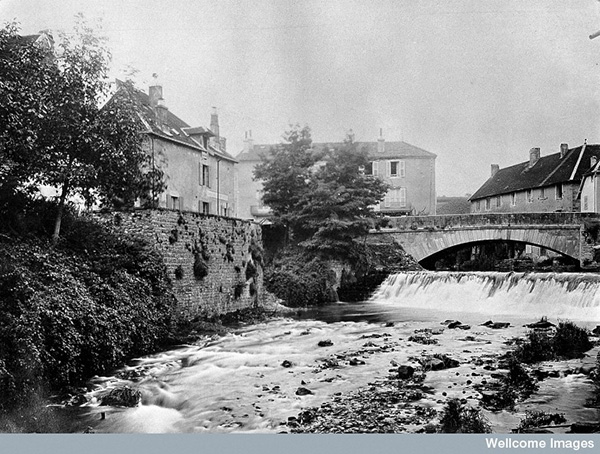
Pasteur family home in Arbois. Image Courtesy of Wellcome Image Library, London
Pasteur was born in Dole, in the east of France, in 1822, but when he was about five, his father moved the family south to Arbois to rent a tannery—a notoriously messy and smelly trade. The area was known for its yellow and straw wines and its perch on the Cuisance River. Pasteur spent his childhood there.
Arbois is where, as a child, Pasteur declared he wanted to be an artist. It’s where he moved back from a Parisian boarding school at the age of sixteen, declaring he was homesick. And it’s where he’d return to spend almost every summer of his adult life. Eventually, Pasteur would bury his mother, father, and three of his children—two of whom died of typhoid fever before they were ten—in Arbois. And it was in Arbois—not in his lab at the prestigious École normale supérieure in Paris, nor in the lab at his university post in Lille—where he bought a vineyard and set up a lab to test his initial ideas about wine and its fermentation.
Before Pasteur developed—which is to say, patented and advocated, just like a twenty-first-century entrepreneurial scientist—“pasteurization” as a way of reducing harmful bacteria in foods and beverages, and before he introduced (and campaigned for) his “germ theory of disease,” which led him to develop the rabies vaccine, Pasteur first worked as a chemist on yeast, specifically researching the fermentation process in wine and spirits.
During the Napoleonic wars at the beginning of the nineteenth century, France’s alcohol industry was dangerously imperiled: Lavoisier, the leading fermenter scientist, had been decapitated, and Britain had cut off France’s supply of cane sugar from the West Indies. Not only were French beer-producers and winemakers, who had wheat and grapes aplenty, still struggling with spoiling yields, but now the spirits-makers had no sugar to wring into hard alcohol. So, in a serious fix, France began cultivating sugar from beets instead. This helped, but forty to fifty years later, when Lille had become France’s capital of beet production, spirits-producers and winemakers alike were still struggling with spoilage; nobody in the alcohol industry knew how to contain or control fermentation.
Lille also happened to be the place where Pasteur worked as a chemistry professor. When one of Pasteur’s students introduced his professor to his father, a spirits-man with fermentation woes, Pasteur suddenly had access and funding to get up close and personal with yeast. He began to watch and parse apart its fermentation, quickly concluding in an 1860 paper that the Berliner Theodor Schwann had been correct decades earlier: yeast was a microbe, a bacterium. In short: alive. He also argued that it was yeast that was so essential to fermentation: its “vital activity,” Pasteur argued, caused fermentation to both begin and end.
Yeast has operated a bit like an oracle over the past two hundred-plus years for many a scientist. It didn’t only convert sugars to alcohol; it also converted Pasteur from chemist to biologist.
More specifically, Pasteur became a microbiologist. The resolution of the discipline-wide fight over the nature of yeast—particularly whether or not it was “vital,” that is, “living”—helped produce two new fields: microbiology and biochemistry. It awakened the scientific community to new possibilities and questions: what other kind of life happens on a small scale, and what can be said about the chemistry of life?
Though Pasteur was catching all sorts of flak over it, by the early 1860s, his fermentation work also caught the attention of an aide to the emperor. The aide was increasingly concerned about the bad rap France’s chief export was accumulating across Europe. If yeast was the key actor in fermenting all alcohol, was it at all related to what most vintners at the time thought damaged and spoiled their wines—what they called l’amer, or “wine disease”? Could it be that yeast was both creator and culprit of this disease?
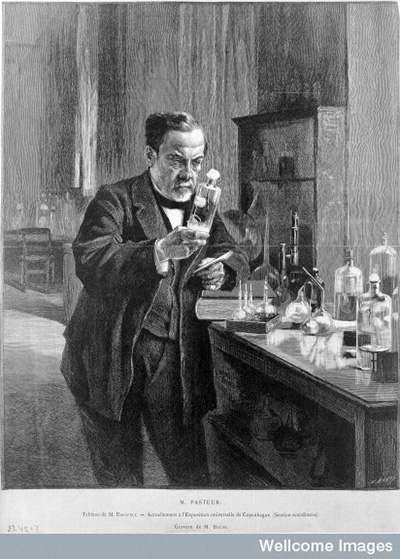
Louis Pasteur (1822–189)], French microbiologist and chemist in his laboratory, Engraving 1885 (By: A.G.A. Edelfelt after: C. Baude).
Image Courtesy of Wellcome Image Library, London
With a presidential commission at his back (Napoleon III was both the last emperor and first president of France), Pasteur set out on a tour of wineries across France. Though it may have been during this sojourn that Pasteur spun the line “A bottle of wine contains more philosophy than all the books in the world,” a drunken holiday this was not. Pasteur solemnly reported back to the crown: “There may not be a single winery in France, whether rich or poor, where some portions of the wine have not suffered greater or lesser alteration.”
And with this, his initial fieldwork completed, Pasteur set up shop in his favorite winery region, Jura, home to, of course, Arbois.
With his light brown eyes, framed by an alert brow and well-earned bags, Pasteur alternately gazed out the window of his rustic laboratory and then down through one of his long white microscopes. Again and again, he watched yeast cavort with grape juice in its fermentation dance. But he knew there was at least one other big player whose influence he had yet to understand fully: air.
Excluding air from the party and allowing it in methodically, he found that exposing yeast and wine to too much air inevitably invites in airborne bacteria, which break down the alcohol into acid, resulting in vinegar. (With one eye on knowledge and one on practical application, Pasteur quickly passed this information on to the vinegar industry.) Air allowed in too much riffraff. In order to keep wine fine, the event had to remain exclusive—or you needed some kind of keen agent to kill the interlopers systematically. It didn’t take Pasteur too long to identify this discriminating friend: heat. Heating the wine, slowly, to about 120˚F would kill the bacteria without destroying the taste of the wine.
Vintners at first found this idea near sacrilege. Many resisted, but after their competitors who adopted the method had bigger, better yields, they quickly complied. In fact, this procedure not only revolutionized winemaking and beer-brewing, saving France’s top export and industry, it was also the beginning of the pasteurization craze and Pasteur’s further work on microorganisms as the germs that transmit infectious disease. Science, profit-making, and improved public health turned out to be mutually reinforcing, each propelling the other forward.
Chapter 5
Mara walked over to the analysis machine to check the progress of the experiment. Points and curves had begun to appear on the screen—each yeast cell’s inner workings translated as numbers and lines.
But Mara was not happy. Comparing these results with the results of two previous experiments, she saw that the difference was big—too big. “Something must have gone wrong,” she said.
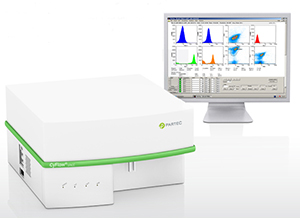
Partec Cyflow
She beckoned Wayne over, and he quickly agreed. “No, this does not look how it should.”
As Pasteur could attest, those who work in labs, wearing white coats, know that experiments often do not work out. It is certainly not the sign of a bad scientist, but it does make lab work tedious. In a speech he gave in his birth place, Dole, Pasteur spoke of his father’s influence in his own lab-bound life: “You, my dear father, whose life was as hard as your trade, you showed me what patience can accomplish in prolonged efforts. To you I owe my tenacity in daily work.”
Getting things right—isolating a potential discovery, testing it, and retesting it—often requires endless attempts, dogged persistence, and the ability to endure a lot of cloudy progress. Wayne contextualized these results thus: “This happens all the time. There is a lot of uncertainty. [It’s as though] failed experiments do not exist: if experiments don’t work, they’re never published, so you don’t know. So you have to reinvent the wheel yourself and develop your own knowledge about what works and what does not. Molecular biology is not like the combustion engine—where billions of pounds have been spent to understand the influence of every parameter and variable. There are still many unknowns in biology, and established methods do not work in every instance.”
Wayne and Mara were in good company, though, which provided some comfort. Working at the Centre, they were not only a part of a community of like-minded scientists, but also a part of a global network of scientists, all working on the modeling of yeast. In 2007, the MCISB hosted and organized a “yeast jamboree,” a three-day all-nighter—a Woodstock for yeast researchers from around the world. The jamboree resulted in a consensus on a partial model of yeast (focused on its metabolism) and a paper summarizing the jamboree’s findings, which have been cited by fellow systems biology researchers more than three hundred times to date. The “yeast jamboree” was so productive that it inspired another jamboree conference—this one focused on the human metabolic system.
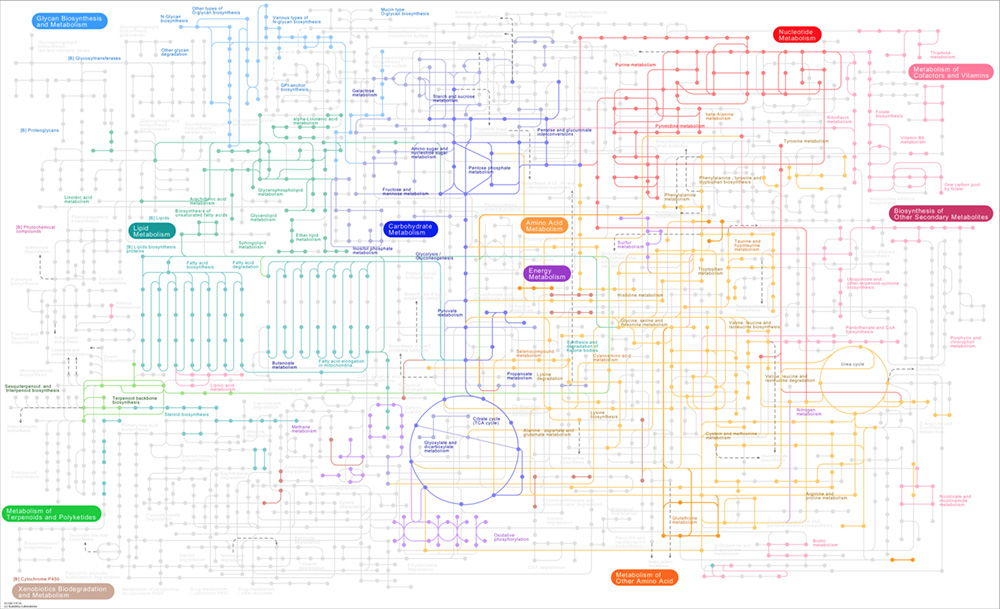
Metaboolic map showing the complexity of the metabolic network in Saccharomyces cerevisiae (budding yeast).
But despite the jamboree’s high-profile success, yeast’s unexpected level of complexity has been a source of frustration for researchers trying to model the whole of it precisely. Three years ago, the Centre’s yeast team started to address this challenge by revising their approach: instead of looking at all of yeast’s genes and determining which proteins each makes and what activity these proteins perform, the team began, first, to identify each activity and, then, research the mechanism behind it. But even with this revised tactic and the doubling down of efforts, a complete model of yeast was not yet done, and time and funding were running out. The promise of extending the grant for another five years was broken when the University, after the global financial crunch, reoriented its priorities. As a result, the funding was almost gone.
“Well,” Mara continued. “These results are clearly not what we are looking for. We have to do it all over again. When do we have time?”
Chapter 6
A year later, on a warm evening in June 2013, Wayne was again working behind the same lab bench.
As much as he enjoyed his work, he could imagine doing other things than sitting in a lab until 10 p.m.: “Read a book, sit in the sun, go to the pub,” he shrugged then gave a wee grin. “You know, have a family.”
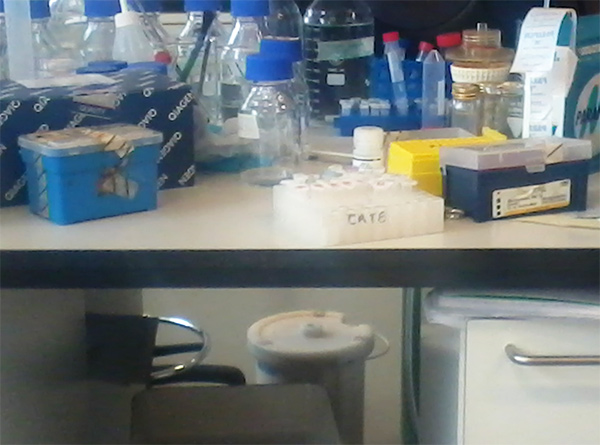
Lab at Manchester Interdisciplinary Biocentre.
Wayne was not working on yeast at the moment, however; he was running a series of enzymology experiments on E. coli for a large European project, trying to finish the results in time for a meeting in Amsterdam. The European grant was covering his salary. That was the only reason he still had a job at MCISB. Other postdocs of the Centre were not so lucky. “There was so much expertise,” Wayne reflected. “It was a good group, and now it has become much smaller. Before, it was much more cohesive; it had much more of a team feel about it. Now the group is fragmented. . . . Everybody is working on different things and in different projects.”
Soon, Wayne would leave Manchester, too, for a lectureship at Aberystwyth University, back home in his seaside Wales. It’s a big deal accomplishment, and Wayne is grateful and thrilled for the opportunity, even as he regrets the loss of the community at MCISB.
The trouble with a burgeoning research lab that ends its work prematurely is that the institutional knowledge and expertise built up in the collaboration are hard to codify, box up, and ship elsewhere. Ideas and emerging discoveries are, in part, relationally based, dependent on the complex interactions and conversations continually rehearsed and refined in a living community—an aspect of the “scientific method” that is rarely remarked upon. These communities can be seen as “knowledge ecologies”: a community cultivates a particular set of expertise and insight that, Wayne explained, includes knowing not only what works, but what doesn’t. As in an ecosystem, a disruption of a particular component in a sprawling chain of connections can affect the health of the whole. Like a living organism, collaboration is a complex system, and in the absence of nourishment—that is, funding—it falls apart and breaks down. As a result, the human capital specific to this community and project with its knowledge of yeast—and especially the collaborative understanding built up around that endeavor—has been lost.
And yet, given all the difficulties the lab had encountered in trying to build a model of yeast, and given that funding for science is never unlimited, and that its outcomes are never predictable, how is it possible to know whether an approach should be abandoned as a dead end or whether it just needs more money and more time to bear fruit?
Wayne fiddled a final pipette into a plastic tray and traipsed toward the analysis machine.
He waited for the graphs to appear. He would repeat this trial three more times before the night was through.
The lab bench next to his sat empty. It had been Mara’s, but above it now hung a paper sign with another name scrawled on it.
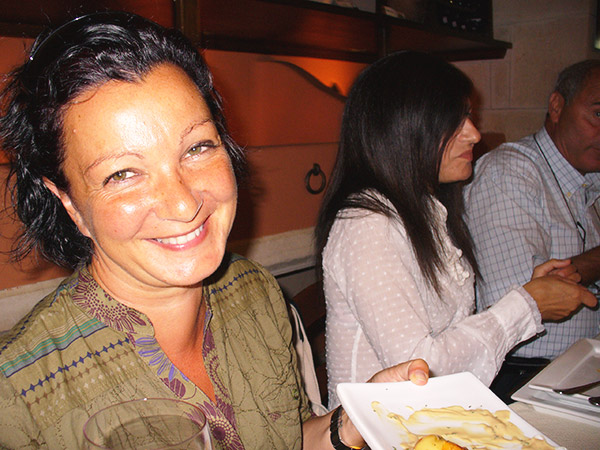
Mara in Vienna 2007
Much of Mara’s yeast work had been aimed at understanding how yeast cells grow, which the researchers had hoped might offer insight into how cancer cells grow. Ironically, while Mara was working on those experiments, her own body was growing a flurry of cancer cells. In 2012, Mara discovered she had bowel cancer, which she first conquered, only to become aware of its return in April 2013. It then quickly spread beyond control.
Mara died at the end of May in 2013. Those remaining at the Centre were devastated by her loss—Mara had been such a young, vibrant, and central presence in the community, and she was gone a year after getting sick. The researchers left at the Centre and other colleagues from the university rented a bus so they could all go to her funeral together.
Wayne was dumbfounded by Mara’s absence. When asked what he learned from her and what he had been feeling with her gone, he replied that though she was “very knowledgeable” and he had “worked with her loads,” right now, he “could hardly summarize.”
Without continued and concentrated funds for the Centre, its future is a little uncertain. Not only is a complete model of yeast still out of reach, so, too, are the insights and contributions such a model might hold for cancer research, larger organ models, the improvement of healthcare, and the entire systems biology community.
Determining that yeast was a living organism took about two hundred years—but it also took more than that. While Pasteur may seem like a one-man revolution, he was also part of a collaboration, albeit one across countries and time. His work built on the works of Kützing, Schwann, and Cagniard-Latour, who worked on yeast twenty years before Pasteur and who built their own works on that of Lavoisier, whose work predated theirs by another fifty years and who likely built his work on the research of his contemporary, Fabbroni. Moreover, it took industry investment, government support, the advent of advanced microscopes, and eminent learned men rassling over its essence before yeast was eventually understood as it is now: a fundamental unit of life.
Wayne and Mara, too, are descendents of this yeast work and scientific struggle. But while Pasteur and his contemporaries’ research was directly inspired and validated by the use of yeast in brewing and baking, Wayne and Mara’s lab is not located in a vineyard. The MCISB yeast researchers work instead in a large white office building, in the middle of Manchester, where, using the tools of modern molecular biology, they probe, pull apart, and map yeast. The small-scale science of Pasteur’s time has grown big—the distance between research and application widening as science has professionalized and institutionalized over time. The vineyard has been replaced by complex configurations of university-based laboratories, specialized health research institutes, pharmaceutical companies, policymaking bodies, regulatory agencies, funding councils, etc.—within which, researchers of all types and stripes try to organize, mobilize, set up shop, and get to the bench or the computer.
Although the modeling of yeast is certainly related to application, insights about life derived from yeast-modeling will likely take some time to result in anything that concretely and directly helps to cure cancer—because the translation of research from lab bench to patient’s bedside is far from straightforward. Sure, these fundamental investigations into the nature of life bring new knowledge, but what, exactly, yeast will teach us and how that will translate into applications is still a little unclear. In other words, whether the promises of the research will become reality is unknown. This uncertainty is difficult to handle—not only for the scientists performing the experiments, building the computer models, and composing the grants, but also for the pharmaceutical industry representatives and government policymakers making funding decisions.
The fundamental character and exact function of yeast were not understood for a long time; now, we’re struggling to understand yeast’s systematic operations. How long will this struggle take? And do we really understand what’s at stake? Within the dilemma of finite funding resources, how do we figure out what research will eventually translate into practice? Pasteur understood the importance of these issues about the funding of research. In 1878, he wrote, “I beseech you to take interest in these sacred domains so expressively called laboratories. Ask that there be more . . . for these are the temples of the future, wealth, and well-being. It is here that humanity will grow, strengthen, and improve. Here, humanity will learn to read progress and individual harmony in the works of nature.”
In many ways, this is what our modern yeast devotees are also hoping to discover: not only how yeast may once again be that ideal lab partner and organism that is also key to the next frontier of science, but that our communities, our funding bodies, and our scientific institutions will continue to invest the needed time, infrastructure, and patience into working with yeast and awaiting the next level of discovery this little organism has to offer us.

